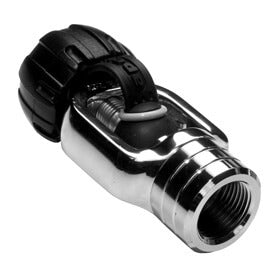Once upon a time the Yoke fitting, also known as A-Clamp or International fitting, was the regulator fitting of choice until along came a European standard connection type called DIN (short for Deutsche Industrie Norm) which offered improved safety and an option for increased cylinder pressure.
So which is better? Is DIN safer? What if you do the majority of your diving in Europe with DIN but holiday somewhere that uses Yoke or vice versa? All are valid questions when deciding what regulator fitting is right for you. Check out our video or read on for more details.
What is the difference?

The Yoke connection uses a clamp type mounting which places an 'A' shaped frame over the cylinder valve and is tightened into place by a screw at the end of the A frame that pushes the first stage into the sealing o-ring on the cylinder valve face. This type of connection can only be used up to a pressure of 232 Bar.

DIN fittings work differently in that the o-ring is fitted to the regulator rather than the cylinder valve and the male thread screw into the cylinder valve to securely capture the o-ring. DIN fittings are available in three variants, but generally only find two variants when it comes to picking a regulator. DIN regulators are typically fitted with an M25 300 bar connection as it will fit both 232 bar and 300 bar cylinder valves and negates the need for manufacturers to produce, test and market an extra model for each regulator. The other variant is a dedicated nitrox regulator which uses an M26 thread so is not compatible with standard M25 DIN cylinder valves.
The difference between 232 and 300 Bar DIN fittings is the number of threads, with 300 bar having a few extra to support the extra pressure and prevent 232 bar rated connections being used in a 300 bar cylinder. A 300 bar regulator will seal correctly in both a 232 bar and 300 bar cylinder valves, but a 232 bar regulator will only work in the 232 bar valve.
Why Choose DIN?
There are five main reasons for opting for DIN over Yoke:
- Increased pressure capacity - DIN can handle up to 300 bar which, if you go by the numbers, offers an extra 120L of air from a 12L 300 bar cylinder (3600L total) compared to the larger but lower pressure 15L 232 bar cylinder (3480L total).
- Seal integrity - The sealing o-ring in a DIN connection is housed in a groove on the first stage of the regulator which means it is less likely to subject to the pinching that can happen with Yoke, it is a lot less likely to fall out and is more protected from exposure to dust, grit and other contaminants.
- Weight - That big lump of chrome plated brass that makes up the 'A' frame and screw of a yoke fitting can add up to a surprising amount of weight. Depending on the manufacturer, you might be looking at saving 200g just by opting for DIN
- Technical diving - DIN is the widely accepted and preferred fitting for technical dive
- Availability - If you do the majority of your diving in Europe or destinations where Europeans dive then DIN cylinder valves will be readily available, and yoke regulators will likely need an adaptor (see below).
In our store at least, for every one yoke regulator sold, we sell four DIN regulators.
Why Choose Yoke?
The reasons to buy a Yoke regulator are definitely fewer, but you can't ignore the fact that there has been literally millions of dives successfully and safely carried out using a yoke fitting.
The biggest reason a diver might choose a yoke regulator is for compatibility with cylinders when diving in North America where yoke is still popular but with the availability of valve converters even that isn't a problem.
Adaptors and Converters
Making the decision to go one way or the other isn't final and permanent. Whether you or for DIN or Yoke there are adaptors and converters that will make your regulator compatible with the other fitting type.
For DIN regulators you can buy screw on DIN to Yoke adaptors that will temporarily convert them for occasional use on a holiday for instance. These are not ideal and certainly not a permanent conversion as they add extra weight to your kit and their design means the first stage sits closer to the back of your head which might cause some discomfort. Some adaptors, like the Scubapro Ultra Light Adaptor, are also made from alloys that are not compatible with the chrome plated brass fitting on the regulator, so it is important to remove them when not in use to prevent them essentially welding together.
For Yoke regulators the temporary conversion is much more subtle with just an insert screwed into the 232 bar cylinder valve to provide you with a surface o-ring to seal against. The only issue is remembering to remove your insert from the valve once you have finished with it, otherwise you'll be regularly buying more.
Personal Choice
At the end of the day it will come down to personal choice and what is best for you and your diving. There are no price differences between yoke and DIN and adaptors are available for both. If you think you might move into technical diving, you can opt for a bit of future proofing and go for DIN.
If push came to shove, and you decide you want to switch then the vast majority of first stages (age depending of course) can be converted by a technician at a cost.










